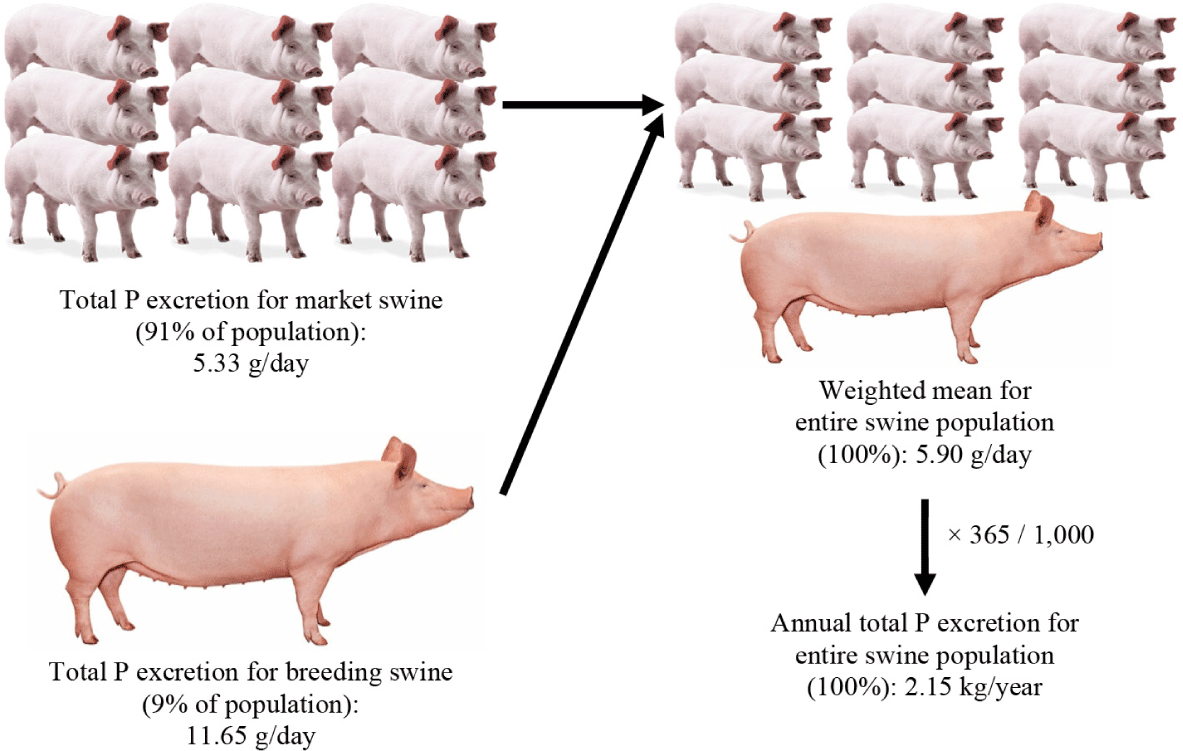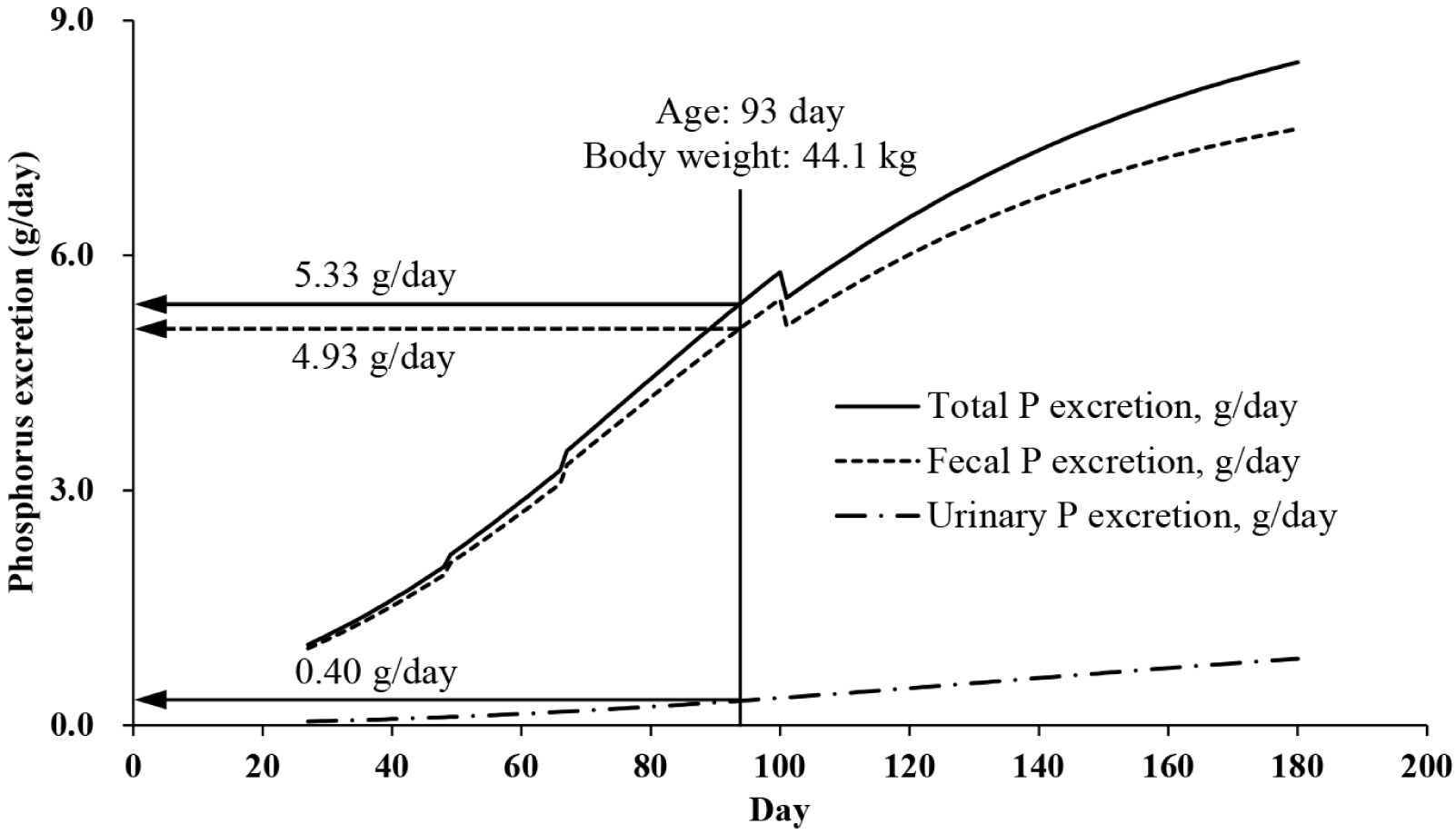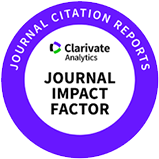INTRODUCTION
Phosphorus (P) plays a crucial role in both the skeletal system and various physiological functions in pigs [1]. In cereal grains, grain by-products, and oilseed meals, approximately two-thirds of P exists in the form of phytate-P with low digestibility in pigs [2,3]. Although exogenous phytase is commonly supplemented in commercial swine diets to improve P digestibility, phytate-P is not completely digested [4–6]. Unabsorbed P is excreted through swine feces, posing a potential risk of environmental pollution such as eutrophication [7,8]. Additionally, the quantities of excreted P would vary based on the types of feed ingredients included, the phytate-P concentration, and the phytase supplementation in swine diets [4–6].
An accurate estimation of P excretion from pigs is essential on a regional or national scale to develop efficient strategies for managing P excretion. Although European Union members routinely assess P excretion in individual countries [9–13], such data are lacking in Korea. In addition, the models for estimating P excretion from swine production developed more than 20 years ago [9–11] would not represent the present pig diets in Korea as the usage of phytase in swine diets has dramatically increased during the last 2 decades. The swine NRC [1] suggests models for pig growth and feed intake that are reasonably close to the Korean pig production systems. Therefore, this study aimed to estimate the annual P excretion per pig in Korea using the total P and phytate-P concentrations in commercial swine diets employing the models in the literature.
MATERIALS AND METHODS
A total of 58 commercial swine diet samples were collected from 16 swine farms in Korea during various growth stages of pigs (Table 1). The diet samples were categorized into piglet phase 1 (7 to 15 kg; n = 11), piglet phase 2 (15 to 25 kg; n = 11), growing phase (25 to 50 kg; n = 10), finishing phase (50 to 121.5 kg; n = 7), gestation phase (n = 9), and lactation phase (n = 9). All samples were finely ground (< 0.1 mm) and stored at 4°C in the refrigerator until chemical analyses. The diet samples were analyzed for P using the molybdenum blue method (method 995.11) by UV spectrophotometer (UV-2450, Shimadzu, Kyoto, Japan) after dry-ash sample preparation as described by the AOAC [14]. Additionally, phytate-P in the diet samples was also analyzed using the commercial phytic acid assay kit (K-PHYT, Megazyme, Bray, Ireland) and the UV spectrophotometer (UV-2450, Shimadzu).
To estimate the daily body weight (BW) for market pigs, the NLIN procedure of SAS (SAS Institute, Cary, NC, USA) was used based on BW and age data from the NRC [1]. The equation used in the Gompertz model [15] was:
where Wt, represents the age at time t (day), A was the BW of the mature pig, b was the growth ratio, k was the maturing rate, and e was the natural logarithm.
where t represents the age of the market pigs (R2 = 0.999 and p < 0.001). The feed intake of market pigs was estimated using the default metabolizable energy (ME) intake equations for gilts and barrows and the effective ME content of the diet suggested by the NRC [1], as follows:
where the average of default ME intake for gilts and barrows was calculated based on the default ME intake curves suggested by the NRC [1]. The values of 3,300 kcal/kg for the effective ME content of the diet and 5% feed wastage were also applied based on the assumption suggested by the NRC [1]. The feed wastage correction coefficient was 0.95. The feed intake for gestating and lactating sows was set at 2.12 and 5.34 kg/day, respectively, adapted from the NRC [1]. Fecal P excretion from pigs was estimated using the total P concentration in the diet, apparent total tract digestible (ATTD) P concentration in the diet, and feed intake as independent variables:
The ATTD P in the diet was estimated using the total P, phytate-P, and phytase concentrations in the diet as independent variables, following the prediction equation suggested by Sung and Kim [6]:
where the total P and phytate-P concentrations in the diet were based on the analyzed data, and the phytase concentration in the diet was assumed to be 500 phytase unit (FTU)/kg for all diets. Urinary P excretion for market pigs was estimated using the following equation suggested by the NRC [1]:
The urinary P excretion for gestating and lactating sows was assumed to be 2.50 and 2.40 g/day, respectively, based on the report by Grez-Capdeville and Crenshaw [16].
Total P excretion from the pigs was calculated as the sum of fecal and urinary P excretions:
The weighted mean of P excretion for breeding sows was calculated based on an estimated country population ratio of 80:20 for gestating sows and lactating sows. Additionally, P excretion for the entire pig was calculated based on an estimated country population ratio of 91:7:2 for market pigs, gestating sows, and lactating sows [17]. An example illustrating the calculation of the weighted mean of total P excretion for the entire swine population is presented in Fig. 1.

Data for P and phytate-P in the diet were analyzed using the MIXED procedure of SAS (SAS Institute, Cary, NC, USA). Each phase was included as a fixed variable in the model. Least squares means were calculated for the dietary total P and phytate-P concentrations for each phase and were compared using the PDIFF option. Each diet was considered an experimental unit. Statistical significance was set at p < 0.05.
RESULTS
The total P concentrations in the diet ranged from 0.54% to 0.66% and did not differ among the phases (Table 1). Dietary phytate-P concentrations in the piglet phases were lower (p < 0.05) than those in other phases.
Fecal, urinary, and total P excretions for market pigs from 7 to 121.5 kg BW at 27 to 180 days of age were 4.93, 0.40, and 5.33 g/day, respectively (Table 2). For gestating sows, fecal, urinary, and total P excretion were 6.70, 2.50, and 9.20 g/day, respectively. Fecal, urinary, and total P excretion of lactating sows were 19.31, 2.40, and 21.71 g/day, respectively. Estimated annual total P excretion was 1.94 kg/year for market pigs, 3.26 kg/year for gestating sows, and 6.89 kg/year for lactating sows. Collectively, the weighted mean of the total P excretion for the entire swine population in Korea was 5.90 g/day or 2.15 kg/year.
2) Phosphorus excretion for the breeding sows was calculated based on the assumption of a population ratio of 80:20 for gestating sows and lactating sows.
3) Phosphorus excretion for the entire pig was calculated based on the assumption of a population ratio of 91:7:2 for market pigs, gestating sows, and lactating sows.
4) The ATTD P in the diet was estimated using the total P, phytate-P, and phytase concentrations in the diet as independent variables, from the literature [6]. Phytase concentration was assumed to be constant at 500 FTU/kg in all diets.
As the age of the pig increases, daily P excretion increases from 0.98 to 7.65 g/day for fecal P excretion and from 0.05 to 0.85 g/day for urinary P excretion (Fig. 2). From 7 to 121.5 kg BW at ages of 27 to 180 days, the total P excretion for market pigs is 5.33 g/day or 0.82 kg/pig per production cycle. The representative BW for the P excretion is 44.1 kg at the age of day 93.

DISCUSSION
In market pigs diets, the analyzed total P concentration of the commercial diets for piglet and growing phases closely matched the requirement estimates in the NRC [1]. However, the analyzed total P concentrations in finishing diets for pigs weighing over 75 kg were greater than the NRC requirement estimates. This deviation in the finishing phase is likely attributed to the assumption that the same diet was provided to the pigs from 50 kg until marketing of pigs in the present work. As pigs grow, their nutrient requirements and concentrations in the diet gradually decrease [1]. Nevertheless, in the Korean swine production system, the diet for growing phase is sometimes fed to growing and finishing phases [18]. Feeding growing diets to finishing pigs is likely a strategy to cope with challenging production conditions, such as hot summers and cold winters in Korea, where feed replacement can be difficult. Therefore, it was assumed that P intake exceeded the requirements for finishing pigs in this study, resulting in higher P excretion compared to diets that marginally met the P requirements for finishing pigs.
In the gestating and lactating sow diets, the analyzed P concentrations were similar to or higher than the values suggested by the NRC [1]. The P content in the gestating sow diets (0.66%) exceeded the NRC [1] requirement estimates (ranging from 0.38% to 0.62%, total P basis), which are based on variables including parity, anticipated gestational weight gain, anticipated litter size, and days of gestation. Similarly, the P content in the lactating sow diets (0.66%) either exceeded or closely matched the requirement estimates (ranging from 0.54% to 0.67%, total P basis), considering variables such as parity, post-farrowing BW, litter size, lactation length, and mean daily weight gain of nursing pigs. Variations between the P concentration of diets in the present study and the suggested requirement estimates by the NRC [1] can be attributed to the inclusion of safety margins for nutrients in the diet formulation process, especially for the gestating and lactating sow diets, which are typically fed as a single diet throughout each phase.
Research on P utilization and excretion in pigs has been conducted in several countries [9–13]. P excretion can be expressed in two ways. The first expression quantifies the amount of P excreted by pigs during their entire life or during a specific production period in kilograms per pig. For example, Jongbloed et al. [11] reported a P excretion of 0.19 kg/pig for piglets weighing from 7.5 to 30 kg BW in Denmark. Additionally, CORPEN reported a P excretion of 0.74 kg/pig for pigs from wean to finish (8 to 108 kg) in France [19]. This approach is particularly relevant for the production cycle of market pigs, which consists of approximately 6 months from birth to slaughter. The second expression for P excretion was the annual amount (kg/year), typically applied to breeding sows that live for more than a year [9,10]. Our study provides information on P excretion in market pigs based on age and BW, allowing for conversion to production period-based excretion as well as daily or yearly excretion values.
The breeding sows were categorized as gestating or lactating. In typical commercial swine farms, newborn piglets have a suckling period lasting 3 to 4 weeks, with a weaning weight of approximately 6.5 to 7.5 kg. This study assumed that nutrient intake during the suckling period was solely from sow milk. Consequently, the amount of feed intake from the diet for pigs under 7.0 kg was set to zero. Therefore, the estimated P excretion of market pigs ranged from 7 to 121.5 kg BW at ages of 27 to 180 days.
The estimated P excretion for market pigs with a BW ranging from 7 to 121.5 kg in this study agreed with values reported in the literature [9–13,19]. However, P excretion for breeding sows (4.25 kg/year) in this study was relatively lower than the values reported in the literature. CORPEN [19] reported sow P excretion in France as 5.10 kg/year (with standard feeding) and 6.50 kg/year (with 2-phase feeding). Jongbloed et al. [11] also reported sow P excretion as 6.92 kg/year in Denmark, 6.71 kg/year in France, and 4.04 kg/year in the Netherlands. These discrepancies are likely due to factors not considered in the estimation of P excretion for breeding sows in this study, such as phytase efficacy [20], variations in P digestibility during gestation and lactation periods [21], and reproductive performance. Another important factor for discrepancies is the amount of P excretion for suckling pigs. Studies on P excretion in sows have reported the amounts of P excretion measured with their offspring [9–11,13,19]. However, the present study did not consider the P excretion for suckling pigs because the estimation was based on the P and phytate-P concentrations in commercial diets. More research on P excretion from suckling pigs is needed.
The BW specifications for pigs in different growth stages vary among the NRC [1], CVB [22], and Korean Feeding Standards for Swine [23]. The Gompertz growth curve for BW was adapted using NRC [1] data. However, the calculation of ATTD P (g/kg of diet) to determine fecal P excretion utilized the actual weights of pigs fed each diet, as outlined in Table 1. Consequently, fecal P excretion in market pigs was calculated based on the phase feeding of the four different diets throughout their lifetime.
For pigs weighing over 7 kg, ATTD P was calculated based on the analyzed data for total P and phytate-P contents in each diet fed according to their weight. The prediction equation for ATTD P in the diet, as suggested by Sung and Kim [6], was applied by incorporating the total P, phytate-P, and a constant phytase concentration of 500 FTU/kg in all diets, a common phytase supplementation level in commercial swine diets [24]. As a result, the ATTD P values varied depending on the total P and phytate-P content of the diets. Therefore, Fig. 2 illustrating P excretion, confirms the discontinuation in excretion levels at the point of diet transition.
Based on the results of this study, the annual excretion of fecal P was calculated by multiplying the fecal P excretion (Table 2; kg/year) by the entire swine population in Korea (11.1 million pigs; [17]), resulting in 20,994 tons/year. We validated this annual fecal P excretion by comparing it with the production weight of swine feed in Korea. Utilizing data on the production weight of swine feed for respective phases in Korea in 2022 [18] and dietary ATTD P (Table 1; [6]), we calculated the annual fecal P excretion to be 19,062 tons/year. This amount of excretion closely approximates the estimated annual fecal P excretion in the present study, indicating that the present estimations employing the NRC [1] models were fairly reasonable.
Sung and Kim [6] reported that the prediction equation for ATTD P may not be applicable to sows because it is based on observations from growing pigs. Additionally, variations in phytase efficacy [25] and P digestibility [21,26] may occur depending on the gestating or lactating stage of the sow and even during the gestation period. However, because of the lack of an alternative prediction equation that can estimate ATTD P based solely on the dietary concentrations of P and phytate-P, the equation suggested by Sung and Kim [6] was utilized. The calculated ATTD P values for gestating and lactating sows using this equation were higher than the values recommended by the NRC [1] for gestating and lactating sows. Consequently, the P excretion estimated in this study for breeding sows may have been underestimated compared to the actual values.
Taken together, the P excretion of pigs for each growing phase was estimated based on the total P and phytate-P concentrations in commercial swine diets. The total annual P excretion for market pigs was estimated to be 1.94 kg/year, equivalent to a pig with a BW of 44.1 kg at 93 days of age. For gestating and lactating sows, the total annual P excretion was estimated to be 3.36 kg/year and 7.92 kg/year, respectively. Assuming a population ratio of 91:7:2 for market pigs, gestating sows, and lactating sows, the annual P excretion from all market and breeding swine in Korea was estimated to be 2.15 kg/year. Further research is required to validate our estimation through in vivo experiments using commercial diets.
















